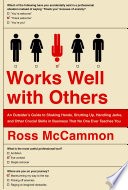

Collaboration is essential in today's diverse work environments. The book emphasizes that no one can achieve success in isolation; teamwork is the cornerstone of innovation and productivity. The author discusses various case studies showcasing how effective collaboration leads to better outcomes in projects. By working together, individuals can leverage each other's strengths and compensate for weaknesses, creating a more balanced and effective team. The book also highlights the importance of establishing trust among team members, as trust fosters open communication and encourages creative problem-solving. Furthermore, the author provides practical strategies for enhancing collaboration, such as setting clear goals, defining roles, and encouraging a culture of feedback.
Continue readingCommunication is a vital skill in any collaborative environment. The author delves into the nuances of effective communication, including active listening, clarity in expression, and non-verbal cues. The book outlines techniques for improving communication, such as using 'I' statements to express feelings without blaming others and practicing empathy to understand different perspectives. The importance of adapting communication styles to suit different audiences is also emphasized. The author shares anecdotes highlighting the consequences of poor communication, which can lead to misunderstandings and conflicts, ultimately hindering team performance. By mastering communication skills, individuals can foster a more cohesive and productive work environment.
Continue readingDiversity in the workplace brings a wealth of perspectives and ideas, which can enhance creativity and innovation. The book discusses the benefits of embracing diversity, including improved problem-solving and decision-making capabilities. The author argues that diverse teams are more likely to challenge the status quo and come up with groundbreaking solutions. However, the book also addresses the challenges that diversity can bring, such as potential conflicts and communication barriers. To harness the power of diversity, the author suggests creating an inclusive culture where all voices are heard and valued. Practical tips for fostering inclusivity, such as implementing mentorship programs and promoting diverse leadership, are provided.
Continue readingConflict is an inevitable part of collaboration, but it can also be a catalyst for growth if managed effectively. The book outlines various conflict resolution strategies, emphasizing the importance of addressing issues promptly and constructively. The author introduces techniques such as interest-based negotiation, where parties focus on their underlying interests rather than positions. The book also discusses the role of mediation in resolving conflicts, encouraging open dialogue and collaboration between conflicting parties. By viewing conflict as an opportunity for improvement rather than a setback, teams can strengthen their relationships and enhance overall performance.
Continue readingA collaborative culture is essential for sustained teamwork and innovation. The author emphasizes that leaders play a crucial role in fostering such a culture by modeling collaborative behaviors and encouraging team members to do the same. The book outlines key elements of a collaborative culture, including shared values, mutual respect, and a focus on collective success. The author provides actionable steps for leaders to create this environment, such as recognizing and rewarding collaboration, promoting open communication, and providing opportunities for team-building activities. By prioritizing a collaborative culture, organizations can enhance employee engagement and drive better results.
Continue readingIn a rapidly changing work environment, continuous learning and adaptability are critical for success. The author argues that individuals and teams must be willing to embrace change and seek out new knowledge and skills. The book discusses the importance of fostering a growth mindset, where challenges are viewed as opportunities for learning rather than threats. The author provides strategies for promoting continuous learning within teams, such as encouraging experimentation and providing access to training resources. By cultivating a culture of adaptability, organizations can remain competitive and responsive to market changes.
Continue readingLeadership is pivotal in shaping collaborative efforts within teams. The book explores different leadership styles and their impact on collaboration, emphasizing that leaders should be facilitators rather than dictators. The author discusses the importance of emotional intelligence in leadership, as understanding and managing one's emotions can significantly influence team dynamics. The book also highlights the significance of empowering team members, encouraging them to take ownership of their work and contribute to decision-making processes. By adopting a supportive and inclusive leadership approach, leaders can create an environment where collaboration thrives.
Continue reading